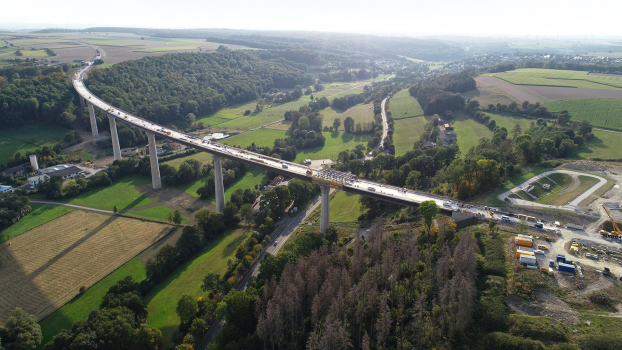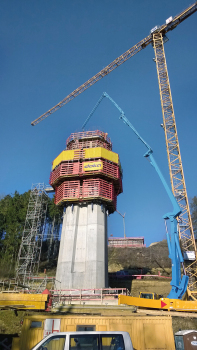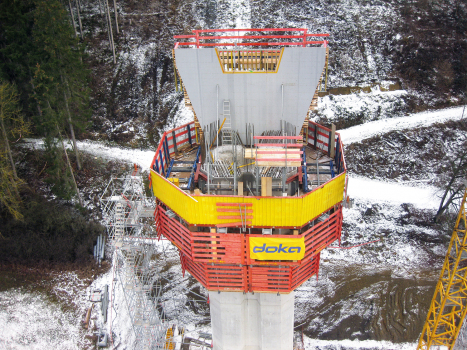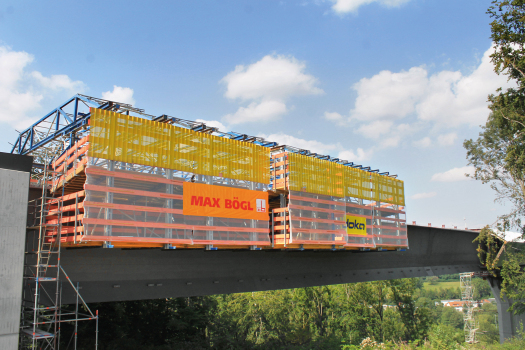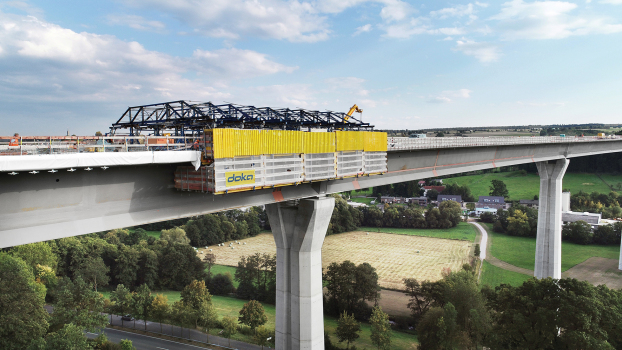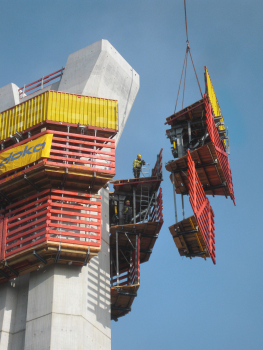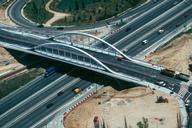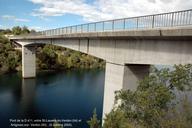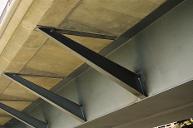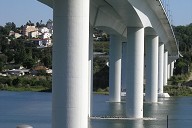The bridge over the Afte near Bad Wünnenberg
Bridges are made to drive over them, preferably as quickly as possible; one never knows what could happen. There is even a technical term for it: gephyrophobia, fear of bridges. And yet these valley-spanning artifacts are the art of engineering at its finest, such as the new Afte Valley Bridge in North Rhine-Westphalia. Time to pay tribute to this achievement of bridge engineering.
Media
Anyone who drives a car knows what it's like: slow down, a warning sign à la danger of slippery roads or crosswinds, plus the obligatory windsock - and a short clack at the transition structures where it goes up and down again. That's all you usually notice about a bridge. Its true beauty is rarely revealed to the traveler. Who is familiar with the name of a bridge, let alone the names of the companies involved in its construction?
Probably hardly anyone has heard of the team led by Matthias Urban and Markus Mühlnickel from the formwork specialists Doka. Although they are actually always on hand when a complex bridge project is on the agenda somewhere in Germany - and concrete plays a role in it. It doesn't matter whether it's cantilevering, incremental launching or on feed scaffolding/supporting scaffolding. An impressive example is the steel and concrete colossus known as the Afte Valley Bridge - almost 800 meters long, with piers around 66 meters high, some of them up to 120 meters apart. A viaduct that is intended to relieve the pressure on Bad Wünnenberg in Westphalia and, in the longer term, make the journey between Brilon and Paderborn more relaxed.
Urban, the project manager, says, "This is an imposing, very long and long-span bridge, and the piers are very massive. You don't get that very often." And that's saying something: Doka hasn't just been supplying equipment and engineering know-how for cross-valley and cross-river transport routes like a Lahn Valley Bridge, a Nuttlar, Pfädchensgraben or Tiefenbach since yesterday. Even after 15 and 27 years on the job, the engineers say, "we are a department that burns for bridges. Mühlnickel, the group leader, quotes Antoine de Saint-Exupéry, who wrote that it is necessary to awaken in people a longing for the wide, endless sea, because then it is much easier to build a ship. This probably also applies to bridges: It is best to have the flowing traffic in front of your eyes right at the beginning. That's how motivation and enthusiasm come about. A bridge, says the engineer, is always exposed and significantly shapes the landscape. It's a nice feeling to see how it grows and ultimately creates connections between places and people.
"Bridges are classic engineering structures," says Urban, because they usually consist of abutments and piers, pier heads and a superstructure. Nevertheless, they only look alike at first glance. At second glance, they contain quite a bit of different engineering. And the formwork requirements grow with the complexity of the bridge geometry. In this respect, the Aftetal is in the league of the more demanding structures - with its height, the challenging geometry of its piers, the massive pier heads, and not least because of its length and span. In principle, standard systems are also used for such a project. However, some areas always have to be solved individually. Urban speaks of the "extra engineering work" that goes into bridges, of special solutions and interface planning, without which it is not possible. A good formwork supplier not only delivers components and systems. He knows how to get the maximum out of them for the project. This is about process, schedule and cost reliability.
We receive plans and often hear: "You must have something ready-made in your drawer," adds Mühlnickel. But with bridges like this, there is no drawer. You sit down with the project partners, involve the team, plan, calculate, check, revise, meet again and coordinate further. "It's a struggle to find the best concept, which ideally is also the safest," says Mühlnickel. "After all, the workers want to get home safely to their families in the evening." And even if the risk of falls is eliminated, it's important that the equipment is ergonomic and minimizes physical strain.
It is up to Doka to be a good advisor to its partners, pointing out the advantages and disadvantages of this or that method, making the right decisions in terms of provision and deployment time - and, on top of that, designing solutions that are good for life and limb; Return on Prevention, as the jargon goes. Studies have shown that every euro invested in safe and ergonomic work aids pays off twice and three times over.
So before a bridge in the true sense of the word can be built, interpersonal bridges must first be built. Only in this way can great things - like the Afte Valley Bridge - come into being. For the massive piers, the contractor responsible, Max Bögl, relied on the principle of self-climbing formwork. The powerful, fully hydraulic system of the Doka pushed itself precisely upwards, cycle by cycle. Always between five and six meters, up to the V-shaped pier heads, which again demanded a different special solution from the formwork experts.
This is where the formwork pre-assembly team came in. This Doka service pays off particularly when it comes to assembly operations that are not commonplace, such as erecting and dismantling or moving the formwork from one pier head to the next - especially as the in-house Doka service means fewer interfaces and less coordination work for the site. Speaking of which: As well as cost savings, it is always the time factor that keeps the project partners open to innovative or unconventional solutions. For the Afte Valley Bridge, for example, Max Bögl used two composite formwork carriages to join the steel trough with the concrete of the carriageway slab. For the construction of the bridge caps with parapet wall, a composite formwork carriage with two trailing cap formwork carriages, so-called formwork carriages TU, were in action. This "pas de deux" saved a lot of time, as the engineers summed up with satisfaction - especially since here, too, the site relied on the experienced practitioners of formwork pre-assembly.
What remains of the Afte Valley Bridge project after four years?
The joy of having looked after it holistically. That the topic of safety was given a high priority. And that consulting and service were also very high on the agenda. And not just because high, far and above is the nature of bridge structures.
|
In a nutshell: |
|
|---|---|
|
Project: |
New construction of the Bad Wünnenberg bypass, Afte Valley Bridge, B 480n |
|
Location: |
Bad Wünnenberg, Germany |
|
Builder: |
Roads. NRW - State Roadworks |
|
Construction company: |
Max Bögl Group of Companies |
|
Formwork systems: |
Self-climbing formwork SKE100 plus, Large-area formwork FF 20, Large-area formwork Top 50, Composite formwork carriage, Cap formwork carriage TU |
|
Services: |
Technical processing, structural analysis, formwork pre-assembly, foreman, project management |
|
Construction time: |
2016 until end of 2021 |
References
Structure Types
- About this
data sheet - Product-ID
8028 - Published on:
09/06/2022 - Last updated on:
23/06/2022

